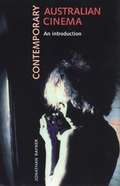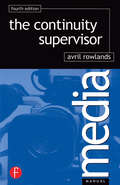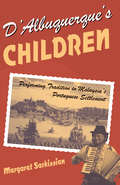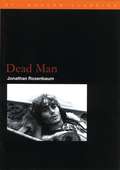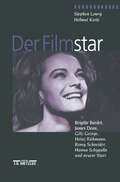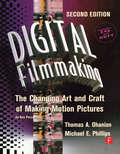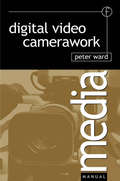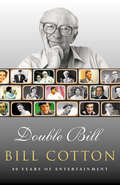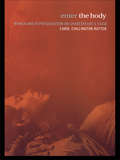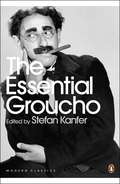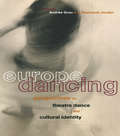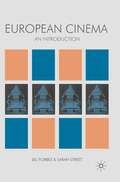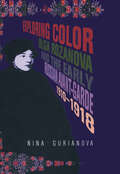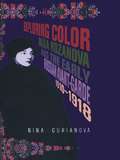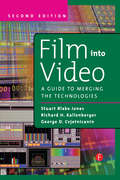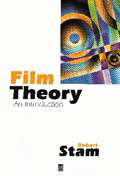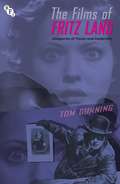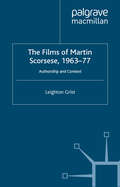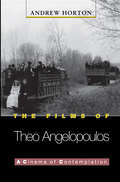- Table View
- List View
Contemporary Australian cinema: An introduction
by Jonathan RaynerProvides an introduction to the products and context of the new Australian film industry which arose toward the end of the 1960s. Traces the development of Australian film, in terms of prominent directors and stars, consistent themes, styles and evolving genres. The evolution of the film genres peculiar to Australia, and the adaptation of conventional Hollywood forms (such as the musical and the road movie) are examined in detail through textual readings of landmark films. Films and trends discussed include: the period film and Picnic at Hanging Rock; the Gothic film and the Mad Max trilogy; camp and kitsch comedy and the Adventures of Pricilla, Queen of the Desert. The key issue of the revival (the definition, representation and propagation of a national image) is woven through analysis of the new Australian cinema.
Continuity Supervisor
by Avril RowlandsThe Continuity Supervisor is a practical guide to the basics of continuity, designed to be of use both to the newcomer and those more experienced. Formerly titled 'The Continuity Handbook: a guide for single-camera shooting, this new edition covers the latest technological changes which affect the Continuity Supervisor. Avril Rowlands worked at the BBC for any years as a PA. She has been involved in specialised training for the television industry and major film and television colleges. Her highly acclaimed residential courses attract students from major television companies worldwide. She is also a writer and independent television producer.
Continuity Supervisor
by Avril RowlandsThe Continuity Supervisor is a practical guide to the basics of continuity, designed to be of use both to the newcomer and those more experienced. Formerly titled 'The Continuity Handbook: a guide for single-camera shooting, this new edition covers the latest technological changes which affect the Continuity Supervisor. Avril Rowlands worked at the BBC for any years as a PA. She has been involved in specialised training for the television industry and major film and television colleges. Her highly acclaimed residential courses attract students from major television companies worldwide. She is also a writer and independent television producer.
D'Albuquerque's Children: Performing Tradition in Malaysia's Portuguese Settlement (Chicago Studies in Ethnomusicology)
by Margaret SarkissianWhen the Portuguese seafarer Afonso de Albuquerque conquered the bustling port of Malacca in 1511, he effectively gained control of the entire South China Sea spice trade. Although their dominance lasted only 130 years, the Portuguese legacy lies at the heart of a burgeoning tourist attraction on the outskirts of the city, in which performers who believe they are the descendants of swashbuckling Portuguese conquerors encapsulate their "history" in a cultural stage show. Using historical and ethnographic data, Margaret Sarkissian reveals that this music and dance draws on an eclectic array of influences that span the Portuguese diaspora (one song conjures up images of Lucille Ball impersonating Carmen Miranda on "I Love Lucy"). Ironically, she shows, what began as a literate tradition in the 1950s has now become an oral one so deeply rooted in Settlement life that the younger generation, like the tourists, now see it as an unbroken heritage stretching back almost 500 years. A fascinating case of "orientalism in reverse," D'Albuquerque's Children illuminates the creative ways in which one community has adapted to life in a postcolonial world.
Dead Man (BFI Film Classics)
by Jonathan RosenbaumWhen it was released in 1995, Dead Man puzzled many audiences and critics. Jim Jarmusch's reputation was for directing slick, hip contemporary films. And Dead Man was a black-and-white Western. As time has passed, though, the number of its admirers has grown rapidly. Indeed Dead Man, with its dark and unconventional treatment of violence, racism and capitalism, may be Jarmusch's finest work to date.This is Jonathan Rosenbaum's view. For him, Dead Man is both a quantum leap and a logical next step in Jarmusch's career. Starring Johnny Depp as the uprooted accountant William Blake and Gary Farmer as his enigmatic Native American companion, Nobody, and with startling cameos from Robert Mitchum, John Hurt and Iggy Pop, Dead Man is by turns shocking, comic and deeply moving. This book explorers and celebrates a masterpiece of 1990s American cinema.
Der Filmstar: Brigitte Bardot, James Dean, Götz George, Heinz Rühmann, Romy Schneider, Hanna Schygulla und neuere Stars
by Helmut Korte Stephen LowryFilmstars gehören zu den bekanntesten öffentlichen Personen des 20. Jahrhunderts. In exemplarischen Untersuchungen zu Stars wie Brigitte Bardot, James Dean, Götz George und Heinz Rühmann, stellt die tiefgründige Analyse die wesentlichen filmischen, kulturellen und historischen Aspekte des Starphänomens dar. Weitere Kapitel legen die Grundlagen für eine Theorie des Filmstars und diskutieren die aktuellen Entwicklungen im Starkino der 90er Jahre.
Digital Filmmaking: The Changing Art and Craft of Making Motion Pictures
by Thomas Ohanian Natalie PhillipsDigital Filmmaking has been called the bible for professional filmmakers in the digital age. It details all of the procedural, creative, and technical aspects of pre-production, production, and post-production within a digital filmmaking environment. It examines the new digital methods and techniques that are redefining the filmmaking process, and how the evolution into digital filmmaking can be used to achieve greater creative flexibility as well as cost and time savings. The second edition includes updates and new information, including four new chapters that examine key topics like digital television and high definition television,making films using digital video, 24 P and universal mastering, and digital film projection. Digital Filmmaking provides a clear overview of the traditional filmmaking process, then goes on to illuminate the ways in which new methods can accomplish old tasks. It explains vital concepts, including digitization, compression, digital compositing, nonlinear editing, and on-set digital production and relates traditional film production and editing processes to those of digital techniques. Various filmmakers discuss their use of digital techniques to enhance the creative process in the "Industry Viewpoints" sections in each chapter .
Digital Filmmaking: The Changing Art and Craft of Making Motion Pictures
by Thomas Ohanian Natalie PhillipsDigital Filmmaking has been called the bible for professional filmmakers in the digital age. It details all of the procedural, creative, and technical aspects of pre-production, production, and post-production within a digital filmmaking environment. It examines the new digital methods and techniques that are redefining the filmmaking process, and how the evolution into digital filmmaking can be used to achieve greater creative flexibility as well as cost and time savings. The second edition includes updates and new information, including four new chapters that examine key topics like digital television and high definition television,making films using digital video, 24 P and universal mastering, and digital film projection. Digital Filmmaking provides a clear overview of the traditional filmmaking process, then goes on to illuminate the ways in which new methods can accomplish old tasks. It explains vital concepts, including digitization, compression, digital compositing, nonlinear editing, and on-set digital production and relates traditional film production and editing processes to those of digital techniques. Various filmmakers discuss their use of digital techniques to enhance the creative process in the "Industry Viewpoints" sections in each chapter .
Digital Video Camerawork (Media Manuals Ser.)
by Peter WardThis manual introduces digital camerawork techniques used in television and video production. Written as a practical guide, the author's step-by-step instructions take you through everything you need to know, from camera controls, to editing, lighting and sound. This text provides a solid foundation to build upon in the area of digital video production. In a period of transition between analogue and digital acquisition/recording formats Digital Video Camerawork provides up-to-date information familiarizing you with the different production styles and requirements. Diagrams are used to illustrate the technology and techniques explained.Digital Video Camerawork combines clear, technical explanations with practical advice. It is ideal for the less experienced broadcast camera operator and for students on media and television production courses.
Digital Video Camerawork
by Peter WardThis manual introduces digital camerawork techniques used in television and video production. Written as a practical guide, the author's step-by-step instructions take you through everything you need to know, from camera controls, to editing, lighting and sound. This text provides a solid foundation to build upon in the area of digital video production. In a period of transition between analogue and digital acquisition/recording formats Digital Video Camerawork provides up-to-date information familiarizing you with the different production styles and requirements. Diagrams are used to illustrate the technology and techniques explained.Digital Video Camerawork combines clear, technical explanations with practical advice. It is ideal for the less experienced broadcast camera operator and for students on media and television production courses.
Double Bill (Text Only): 80 Years Of Entertainment
by Bill CottonPacked with anecdotes, sparkling insights into the changing nature of show business and the turbulent world of the BBC, and boasting a glittering cast-list, Double Bill is a fascinating read, unashamedly nostalgic and often hilarious.
Enter The Body: Women and Representation on Shakespeare's Stage
by Carol Chillington RutterEnter the Body offers a series of provocative case studies of the work women's bodies do on Shakespeare's intensely body-conscious stage. Rutter's topics are sex, death, race, gender, culture, politics, and the excessive performative body that exceeds the playtext it inhabits. As well as drawing upon vital primary documents from Shakespeare's day, Rutter offers close readings of women's performance's on stage and film in Britian today, from Peggy Ashcroft's (white) Cleopatra and Whoopi Goldberg's (whiteface) African Queen to Sally Dexter's languorous Helen and Alan Howard's raver 'Queen' of Troy.
Enter The Body: Women and Representation on Shakespeare's Stage
by Carol Chillington RutterEnter the Body offers a series of provocative case studies of the work women's bodies do on Shakespeare's intensely body-conscious stage. Rutter's topics are sex, death, race, gender, culture, politics, and the excessive performative body that exceeds the playtext it inhabits. As well as drawing upon vital primary documents from Shakespeare's day, Rutter offers close readings of women's performance's on stage and film in Britian today, from Peggy Ashcroft's (white) Cleopatra and Whoopi Goldberg's (whiteface) African Queen to Sally Dexter's languorous Helen and Alan Howard's raver 'Queen' of Troy.
The Essential Groucho: Writings by, for and about Groucho Marx (Penguin Modern Classics)
by Stefan KanferNo, Groucho is not my real name, I'm just breaking it in for a friend.' Presenting the greatest and most hilarious examples of Groucho, one of the most influential and well-loved figures in the long and glittering history of comedy. From early scripts to complete screenplays, from magazine funnies to fascinating personal correspondence, via books, greedy banks, even greedier lawyers and the coming of television, Kanfer's collection captures the essence of Groucho's inimitable comic genius. 'I never forget a face, but in your case I'll make an exception...
Europe Dancing: Perspectives on Theatre, Dance, and Cultural Identity
by Andree Grau Stephanie JordanEurope Dancing examines the dance cultures and movements which have developed in Europe since the Second World War. Nine countries are represented in this unique collaboration between European dance scholars. The contributors chart the art form, and discuss the outside influences which have shaped it. This comprehensive book explores: * questions of identity within individual countries, within Europe, and in relation to the USA * the East/West cultural division * the development of state subsidy for dance * the rise of contemporary dance as an 'alternative' genre * the implications for dance of political, economic and social change. Useful historical charts are included to trace significant dance and political events throughout the twentieth century in each country. Never before has this information been gathered together in one place. This book is essential reading for everyone interested in dance and its growth and development in recent years.
Europe Dancing: Perspectives on Theatre, Dance, and Cultural Identity
by Andree Grau Stephanie JordanEurope Dancing examines the dance cultures and movements which have developed in Europe since the Second World War. Nine countries are represented in this unique collaboration between European dance scholars. The contributors chart the art form, and discuss the outside influences which have shaped it. This comprehensive book explores: * questions of identity within individual countries, within Europe, and in relation to the USA * the East/West cultural division * the development of state subsidy for dance * the rise of contemporary dance as an 'alternative' genre * the implications for dance of political, economic and social change. Useful historical charts are included to trace significant dance and political events throughout the twentieth century in each country. Never before has this information been gathered together in one place. This book is essential reading for everyone interested in dance and its growth and development in recent years.
European Cinema: An Introduction
by Sarah Street Jill ForbesThe survival of cinema in Europe and the analysis of its heritage are key issues for the new century. This book asks how we can define European cinema and how it should be studied. It provides an overview of the problems, traditions and key questions that have informed the study of European cinema, investigating the links and tensions between Europe and Hollywood and exploring the different experiences of national identities within a common European framework.Twelve case studies of individual European films ranging from The Battleship Potemkin and The Lodger, to La Haine and Trainspotting, illustrate the distinctiveness and variety of cinema in Europe as well as the various critical methods by which it can be studied.With its detailed analysis of films from several European countries including Britain and Russia, the book encourages a comparative approach and raises urgent questions about the future of European cinema in the context of globalization. It will be of interest to students in Film Studies, European Studies and Modern European Languages and Cultures.
Exploring Color: Olga Rozanova and the Early Russian Avant-Garde 1910-1918
by Nina GurianovaThis is an examination of the paintings, books, poetry and theoretical work of Russian avant-garde artist, Olga Rozanova. The text assesses Rozanova's life and work, aiming to recreate the spirit of the counterculture milieu that contributed to the transformation of 20th-century art.
Exploring Color: Olga Rozanova and the Early Russian Avant-Garde 1910-1918
by Nina GurianovaThis is an examination of the paintings, books, poetry and theoretical work of Russian avant-garde artist, Olga Rozanova. The text assesses Rozanova's life and work, aiming to recreate the spirit of the counterculture milieu that contributed to the transformation of 20th-century art.
Film Into Video: A Guide to Merging the Technologies
by George Cvjetnicanin Richard KallenbergerFilm Into Video, Second Edition offers comprehensive, practical information on the complex process of converting motion picture film into video. All of the tools of the trade are explained in clear, simple language, as are the operational, business, and creative sides of film to video transfer. This easy-to use guide provides the reader with the necessary foundation to approach any technological advances in this fast-paced field. Additions to the second edition include: information on the Philips Spirit Data Cine and the new Sony FVS-1000; a new section on the latest in flying spot telecines, including Cintel's C-Reality and Ursa Electrum; an examination of recent changes in color correction computers with da Vinci's 2K and Pandora's Mega-Def systems, and in respect to Philips Spirit DataCine and Cintel's C-Reality, a discussion relating to the area of data transfer and how this has changed the telecine industry.
Film Into Video: A Guide to Merging the Technologies
by George Cvjetnicanin Richard KallenbergerFilm Into Video, Second Edition offers comprehensive, practical information on the complex process of converting motion picture film into video. All of the tools of the trade are explained in clear, simple language, as are the operational, business, and creative sides of film to video transfer. This easy-to use guide provides the reader with the necessary foundation to approach any technological advances in this fast-paced field. Additions to the second edition include: information on the Philips Spirit Data Cine and the new Sony FVS-1000; a new section on the latest in flying spot telecines, including Cintel's C-Reality and Ursa Electrum; an examination of recent changes in color correction computers with da Vinci's 2K and Pandora's Mega-Def systems, and in respect to Philips Spirit DataCine and Cintel's C-Reality, a discussion relating to the area of data transfer and how this has changed the telecine industry.
Film Theory: An Introduction (Blackwell Companions In Cultural Studies #Vol. 1)
by Robert StamThis book is a lively and provoking introduction to film theory. It is suitable for students from any discipline but is particularly aimed at students studying film and literature as it examines issues common to both subjects such as realism, illusionism, narration, point of view, style, semiotics, psychoanalysis and multiculturalism. It also includes coverage of theorists common to both, Barthes, Lacan and Bakhtin among others. Robert Stam, renowned for his clarity of writing, will also include studies of cinema specialists providing readers with a depth of reference not generally available outside the field of film studies itself. Other material covered includes film adaptations of works of literature and analogies between literary and film criticism.
The Films of Fritz Lang: Allegories of Vision and Modernity
by Tom Gunningln this volume Tom Gunning examines the films of Fritz Lang not only as a stylistically coherent body of work, but as an attempt to portray the modern world through cinema. The world of modernity in which systems replace individuals is conveyed by Lang's mastery of cinematic set design, composition and editing. Lang presents not only a decades-long vision of cinematic narrative which can be compared to that of Alfred Hitchcock or Jean Renoir, but a view of modernity that relates strongly to the ideas of Adorno, Brecht, Benjamin and Kracauer. From the sweeping allegorical films of the 20s to the chilly and abstract thrillers of the 50s, Lang's films, Gunning claims, are 'among the most precious records of the twentieth century'. The Films of Fritz Lang immeasurably enriches our understanding of a great artist and, in so doing, reimagines what a film arlist is: an author who fades away even in being recognised and interpreted, an enigmatic figure at the junction of aesthetics, history, biography and theory.
The Films of Martin Scorsese, 1963-77: Authorship and Context
by L. GristA study of Martin Scorsese's early career, from his student short films to New York, New York. As well as discussing the films in detail, they are considered in relation both to the issue of film authorship and a period of American cinema marked by crisis and change. Looking at both Scorsese's film-making and the debates surrounding film authorship, this book is also about American film making in the sixties and seventies - about, in short, authorship and context.
The Films of Theo Angelopoulos: A Cinema of Contemplation
by Andrew HortonGreek film director Theo Angelopoulos is one of the most influential and widely respected filmmakers in the world today, yet his films are still largely unknown to the American public. In the first book in English to focus on Angelopoulos's unique cinematic vision, Andrew Horton provides an illuminating contextual study that attempts to demonstrate the quintessentially Greek nature of the director's work. Horton situates the director in the context of over 3,000 years of Greek culture and history. Somewhat like Andrei Tarkovsky in Russia or Antonioni in Italy, Angelopoulos has used cinema to explore the history and individual identities of his culture. With such far-reaching influences as Greek myth, ancient tragedy and epic, Byzantine iconography and ceremony, Greek and Balkan history, modern Greek pop culture including bouzouki music, shadow puppet theater, and the Greek music hall tradition, Angelopoulos emerges as an original "thinker" with the camera, and a distinctive director who is bound to make a lasting contribution to the art form. In a series of films including The Travelling Players, Voyage to Cythera, Landscape in the Mist, The Suspended Step of the Stork, and most recently in Ulysses' Gaze starring Harvey Keitel (winner of the 1995 Cannes Film Festival Grand Prix), Angelopoulos has developed a remarkable cinematic style, characterized by carefully composed scenes and an enormous number of extended long shots. In an age of ever decreasing attention spans, Angelopoulos offers a cinema of contemplation.
